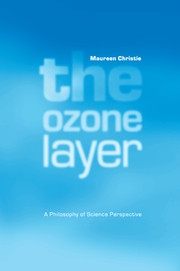Book contents
- Frontmatter
- Contents
- List of figures
- List of abbreviations
- Preface
- 1 Introduction
- Part I History of the understanding of stratospheric ozone
- 2 Stratospheric ozone before 1960
- 3 Chlorinated fluorocarbons
- 4 The Supersonic Transport (SST) debate
- 5 Molina and Rowland: chlorine enters the story
- 6 Too much of a good thing? Crucial data backlog in the Antarctic ozone hole discovery
- 7 Antarctic ozone hole – theories and investigations
- 8 Completing the picture: from AAOE to 1994
- Part II Philosophical issues arising from the history
- References
- Index
2 - Stratospheric ozone before 1960
Published online by Cambridge University Press: 22 September 2009
- Frontmatter
- Contents
- List of figures
- List of abbreviations
- Preface
- 1 Introduction
- Part I History of the understanding of stratospheric ozone
- 2 Stratospheric ozone before 1960
- 3 Chlorinated fluorocarbons
- 4 The Supersonic Transport (SST) debate
- 5 Molina and Rowland: chlorine enters the story
- 6 Too much of a good thing? Crucial data backlog in the Antarctic ozone hole discovery
- 7 Antarctic ozone hole – theories and investigations
- 8 Completing the picture: from AAOE to 1994
- Part II Philosophical issues arising from the history
- References
- Index
Summary
Ozone, O3, is a highly reactive form of oxygen, which is found in trace quantities both in the natural stratosphere (15–50 km altitude), and in polluted surface air. It was discovered and characterised in 1839 by Schönbein. It cannot easily be prepared pure, but can readily be obtained in quantities up to 50 per cent by passing an electric spark discharge through normal oxygen. Ozone is much more reactive than normal molecular oxygen, and is also very toxic.
The presence of ozone in the upper atmosphere was first recognised by Cornu in 1879 and Hartley in 1880. Its particular role in shielding the earth's surface from solar ultraviolet light with wavelength between 220 and 320 nm then became apparent. Meyer (1903) made careful laboratory measurements of the ozone absorption spectrum. Fabry and Buisson (1912) were able to use these results to deduce the amount of ozone present in the atmosphere from a detailed analysis of the solar spectrum. It was not hard for the scientists to deduce that gases in the earth's atmosphere must be responsible for any missing frequencies observed in the spectrum of sunlight. To produce an absorption in the solar spectrum, a molecule must be somewhere on the path of the light from the sun to the earth's surface. The solar atmosphere is much too hot for any molecules to be present, let alone a relatively unstable one like ozone.
- Type
- Chapter
- Information
- The Ozone LayerA Philosophy of Science Perspective, pp. 9 - 16Publisher: Cambridge University PressPrint publication year: 2001



